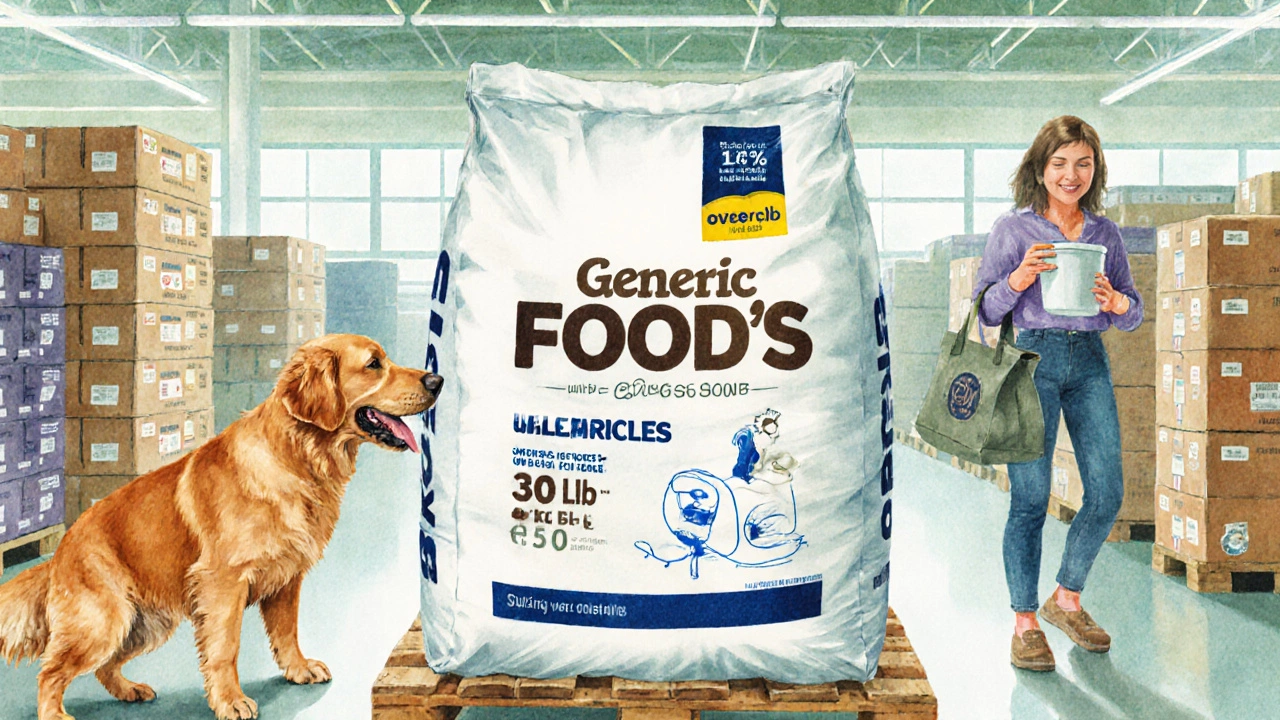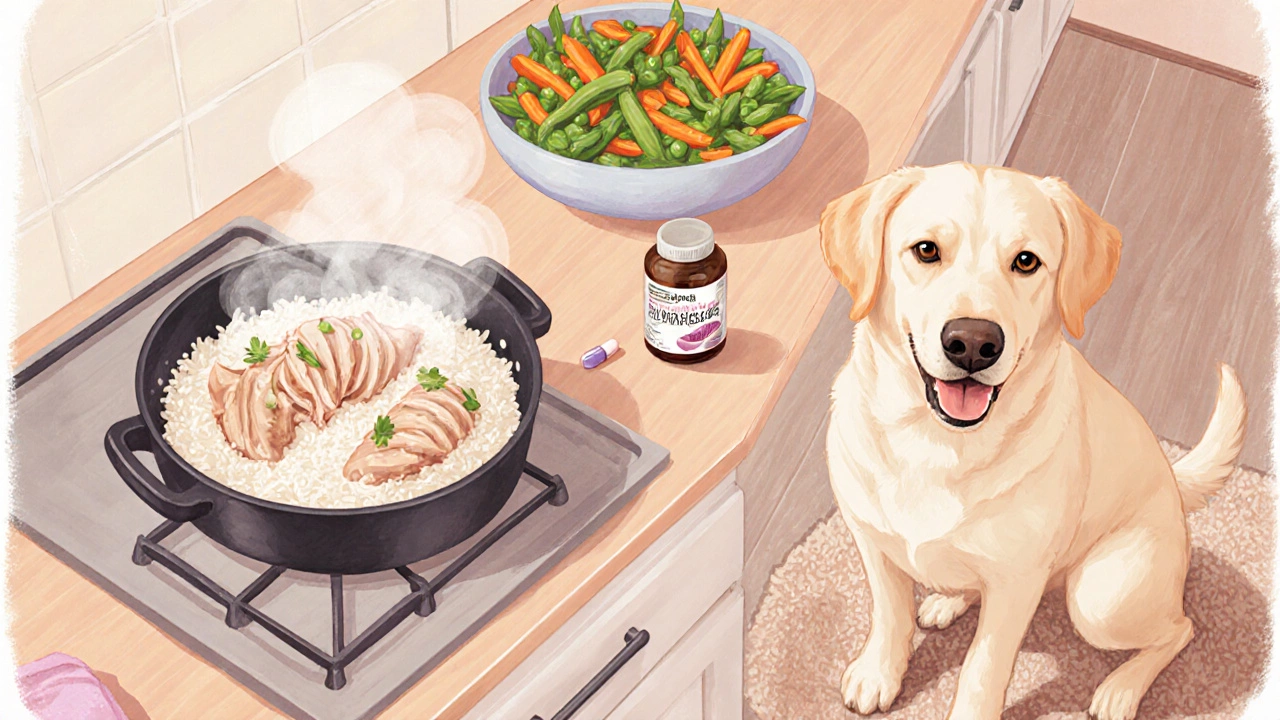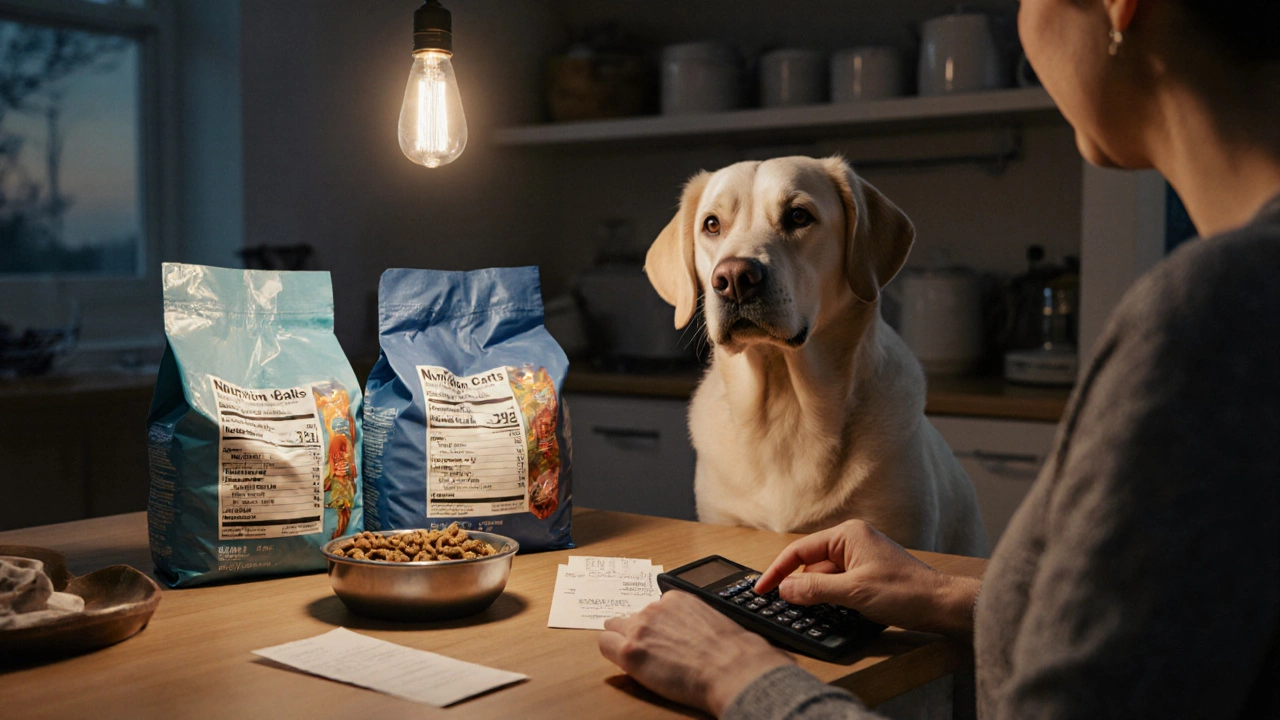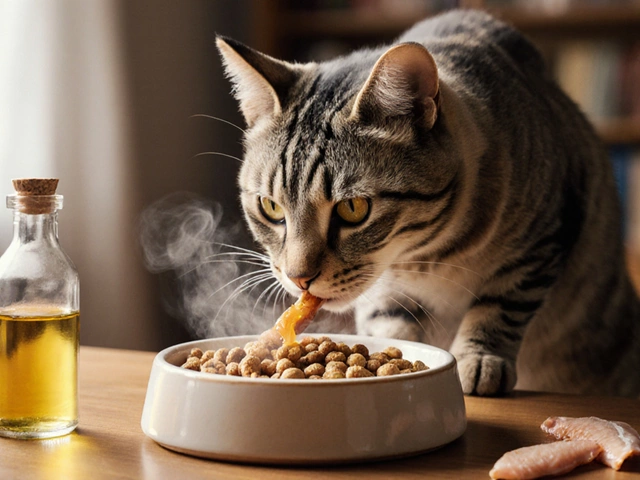Dog Food Cost Calculator
Your Dog's Details
Recommended Options
Store-Brand Dry Kibble
$0.90 per pound
Meets Nutritional BaselineBulk Discount Kibble
$0.65 per pound
Best ValueHomemade Meals (Rice & Chicken)
$0.30 per pound
Requires SupplementDaily Cost Results
Enter your dog's weight and activity level to see costs
Important: Always check food labels for minimum 18% protein and 5% fat to ensure your dog's nutritional needs are met.
Source: AAFCO nutritional standards and article data
When the vet bill is high and the grocery list never ends, figuring out the cheapest dog food that still keeps your pup healthy can feel like a puzzle. Below you’ll find a step‑by‑step guide that blends nutrition basics with real‑world money‑saving tricks, so you can stop guessing and start feeding smart.
Key Takeaways
- Focus on meeting the minimum protein (18% for adults) and calorie needs before chasing the lowest price.
- Store‑brand dry kibble bought in bulk often beats premium cans on a cost‑per‑pound basis.
- Simple homemade meals (rice, chicken, veggies) can be cheaper than commercial food if you watch portions and supplement nutrients.
- Use discount retailers, online subscription programs, and seasonal sales to cut the price further.
- Always balance savings with your dog’s health - cheap food isn’t worth it if it causes vet visits later.
What Counts as "Dog Food"?
Dog Food is a commercially prepared or homemade mixture of nutrients designed to meet a dog’s dietary needs. It comes in three main formats: dry kibble, canned (wet) food, and homemade meals. Each format delivers protein, fat, carbs, vitamins, and minerals, but their price structures differ dramatically.
Understanding the Nutritional Baseline
Before you chase the lowest price tag, make sure you know the minimum nutritional benchmarks set by the Association of American Feed Control Officials (AAFCO). For an adult dog, the diet should provide at least:
- 18% crude protein on a dry matter basis
- 5% crude fat
- Calories ranging from 30-45 kcal per pound of body weight, depending on activity level
- Essential vitamins (A, D, E, K) and minerals (calcium, phosphorus, zinc)
Any food that fails these thresholds can lead to muscle loss, skin problems, or digestive upset - costs that quickly outweigh any savings.
Cheapest Commercial Options
Commercial dog food dominates the market, and many low‑price brands meet AAFCO standards. The biggest savings come from two strategies:
- Store‑brand dry kibble: Supermarket or big‑box store brands (e.g., “Kroger Dog Food” or “Walmart Dog Food”) often cost $0.80-$1.10 per pound. Their ingredient lists are simple-usually chicken meal, corn, and wheat gluten-yet they meet minimum protein ratios.
- Bulk purchases from discount pet stores: Chains like “PetSmart” and “Petco” offer 25‑lb bags priced around $0.70 per pound when you buy during holiday sales or use loyalty points.
Both options keep the cost per day for a 30‑lb Labrador at roughly $0.60, compared to $1.20 for premium brands.

Buying in Bulk & Discount Channels
Bulk purchasing isn’t just about the per‑pound price-it also reduces packaging waste and the frequency of trips to the store. Here’s how to maximize bulk savings:
- Warehouse clubs: Costco and Sam’s Club sell 30‑lb bags of generic kibble for as low as $0.65 per pound.
- Online subscription services: Websites like Chewy.com offer auto‑ship discounts up to 15% plus free shipping, which can shave $0.10-$0.20 per pound.
- Clearance aisles: When a brand is discontinued, you can find 5‑lb bags for $2-$3. Split the bag with a neighbor and store the rest in airtight containers.
Remember to rotate stock every 6 months to keep the food fresh.
Homemade Low‑Cost Meals
Many owners wonder if a kitchen‑cooked diet can beat cheap kibble. The answer is yes-if you follow a balanced recipe and supplement critical nutrients.
A basic, budget‑friendly recipe uses:
- 2 cups of cooked white rice (carbohydrate base)
- 1 cup of boiled, skinless chicken breast, shredded (protein source)
- ½ cup of mixed cooked vegetables (carrots, peas, green beans) for fiber and vitamins
- 1 teaspoon of fish‑oil capsule (omega‑3 fatty acids)
- Optional: a canine multivitamin powder to meet calcium and phosphorus needs
The total cost for a week’s worth of meals for a 30‑lb dog is roughly $5-$6, translating to $0.30 per day-well below commercial options. However, homemade meals lack the guaranteed shelf‑life and require diligent supplementation to avoid deficiencies.
Balancing Cost and Health
It’s tempting to chase the lowest dollar figure, but a three‑step check can keep you from compromising health:
- Check the guaranteed analysis: Look for ≥18% protein and ≥5% fat.
- Read the ingredient list: Whole meats (e.g., chicken, turkey) should appear before fillers like corn or soy.
- Monitor your dog’s weight and coat: If your pup is losing weight or shedding excessively, the food may be too cheap nutritionally.
If any red flag appears, consider moving up a tier or adding a dietary supplement.

Practical Tips to Stretch Your Dog Food Budget
- Buy in larger containers and store extra with a vacuum sealer.
- Mix and match: Blend a small amount of premium kibble with bulk store brand to boost palatability without a huge cost rise.
- Use pet‑friendly leftovers (plain boiled chicken, rice) as occasional top‑ups.
- Take advantage of loyalty programs that reward points for every dollar spent, redeemable for free bags.
- Shop seasonal sales around holidays-many retailers run “Buy One Get One 50% Off” on dog food.
Comparison of Popular Low‑Cost Options
| Option | Cost per Pound | Protein % | Calories (kcal/lb) | Pros | Cons |
|---|---|---|---|---|---|
| Store‑brand dry kibble | $0.90 | 18‑20 | 3400 | Meets AAFCO, easy storage | Lower meat content, possible filler taste |
| Bulk discount kibble (warehouse club) | $0.65 | 19 | 3500 | Best price per pound, longer shelf life | Requires larger storage space |
| Homemade rice & chicken | $0.30 (estimated) | ~22 (from chicken) | 3200 | Fresh ingredients, customizable | Time‑intensive, need supplements |
When Cheap Isn’t Good Enough
Even the cheapest formulas can fail if they’re not suited to your dog’s life stage or health condition. Puppies, senior dogs, and breeds with special needs (e.g., large‑breed joint support) require higher protein or added glucosamine. In those cases, allocate a slightly larger budget toward a targeted formula and offset the cost elsewhere-perhaps by buying treats in bulk.
Frequently Asked Questions
Can I feed my dog only cheap store‑brand kibble?
Yes, as long as the kibble meets AAFCO minimums for protein and fat, and your dog stays at a healthy weight with a shiny coat. Look for a guaranteed analysis of at least 18% protein and 5% fat.
How do I know if a homemade diet is nutritionally complete?
Use a veterinary‑approved recipe or a commercial canine multivitamin supplement. It’s essential to add calcium, phosphorus, and a broad‑spectrum vitamin blend to avoid deficiencies.
Is it safe to store bulk kibble for more than a year?
If kept in an airtight container, away from heat and moisture, kibble can stay fresh for up to 12‑18 months. Rotate older bags forward and mark the purchase date.
What’s the cheapest way to add omega‑3 fatty acids?
A single fish‑oil capsule per day (about $0.05) is an inexpensive source of EPA and DHA. Alternatively, sprinkle a teaspoon of flaxseed oil on the food.
Should I ever mix cheap kibble with homemade meals?
Mixing can improve variety and nutrition, but keep the total calories balanced. Start with a 75% kibble / 25% homemade ratio and adjust based on your dog’s weight.
Saving money on dog food doesn’t have to mean sacrificing health. By checking the basics, buying smart, and adding a few home‑cooked meals, you can keep your furry friend thriving without breaking the bank.





